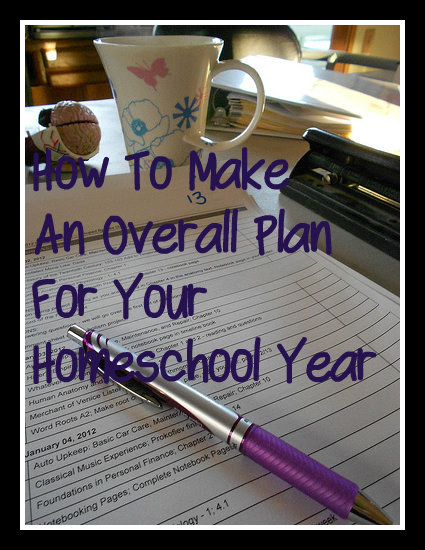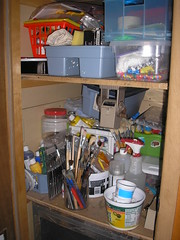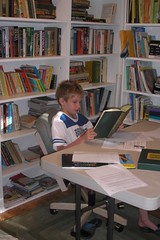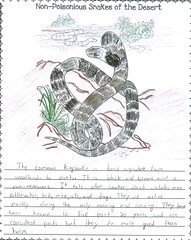Often I am asked by new homeschoolers about how to make an overall plan for the year. They are looking for the nuts and bolts of putting lots of great ideas together because they tend to get overwhelmed by the whole process. I shared the following ideas with a friend and I hope they help with planning the homeschool year and encourage readers here at Curriculum Choice.

I try to emphasis to new homeschoolers that your “school day” extends far beyond the usual school hours. By making good use of that concept you can fit some school related learning into every day of the week and move some of your ideas and projects into the evenings or over the weekends so your whole family can participate.
My Steps To Make An Overall Plan for The Year
1. Consider what you want to teach. What are the main points of the lessons? What are my goals for this particular year? The process of putting these thoughts on paper in a simple form gives a touchstone when considering what books, resources, and other options to use. Remember to balance academic with interest-driven learning.

Take an inventory of what materials you have on hand
2. Gather your materials to see what you have and what you might need:
- Textbooks or workbooks (if you are going to use these)
- Library books (look on your local library website and browse their catalog of books)
- Games and Kits
- Online activities (Google the topic with “lesson plan” after it or “activities” or “unit study”)
- Field trip ideas
- DVDs and Netflix
I usually keep a notebook page for each subject as I am planning and record my ideas on paper as I go.
3. Decide which materials best suit your child. Try to figure out which aspect of what you are learning is going to be most interesting to them.

Some Children Thrive on Reading Lots of Books
- Active learner-Short activities, lots of movement, limited table time.
- Visual Learner-Picture books, videos, lots of art activities.
- Avid Reader-Keep a list of books that can fill in your schedule and don’t forget books for subjects like science, history, and biographies of artists and musicians.
- Project Learner-Kits, models, lapbooks, and notebook pages are great for this kind of learner.
4. Divide the text, books, activities, and field trips into the desired amount of time. I prefer to move slowly through a book and have them give an oral or written narration every day. When your children are young, working up to one paragraph per book selection per day is enough along with a drawing or a map or something that is interesting to them. I never try to do it all. (see #6) You may wish to read this entry on my blog: Simplicity is Best.

Combine writing, art, and science into one project
5. Look for ways to connect subjects:
- History and literature (historical fiction)
- History and art and music (learn about artists and composers from the history time period)
- Science and art (drawing diagrams or labs, drawing animals found in your neighborhood)
- Math and science (measuring things for labs, cooking)
- PE and math (times tables while jump roping, counting repetitions, count as you bounce a ball)
6. Have an overall plan but be flexible.
- Decide if any areas are needing extra attention for this school year, make those a priority and perhaps complete them earlier in the day.

Off Season Traveling is a Great Experience
- Take the opportunity for field trips. This is one reason for home schooling in the first place. Taking field trips when everyone else is back in school is so enjoyable and far less crowded.
- Plan for interruptions. Divide your books into 34 or 35 weeks instead of 38 so you have some wiggle room.
7. Have a plan for things to do when your child is sick:
- Educational videos while laying on the couch.
- Read out loud to your child.
- Listen to classical music while they rest.
- Play quiet games.
8. Make use of your time spent traveling in the car:
- Listen to audio books.
- Listen to folk music or classical music.
- Have a box of books they can read to themselves.
- Have a stack of math facts flashcards (keep in a Ziploc.)
- Have a stack of sight words to read (keep in a Ziploc.)
Hopefully this post has helped you in some way, either with a few ideas to get started with or a some new ideas to try in your homeschool.
~Originally published August 2009.
Written by Barb-Harmony Art mom. She blogs at Harmony Art Mom and Handbook of Nature Study.

Lots of really great ideas! Thanks!
.-= Angie @ Many Little Blessings´s last blog ..7 Quick Takes: August 28 (Vol. 13) =-.
I like what you’ve written. Start with goals. And I love how you add to look at what you’ve GOT next. Don’t start shopping right away. There are so many good curricula and living books. It’s easy to get overwhelmed. Actually, most of us have lots of valuable, unused resources on our shelves. Great advice, Barb!
.-= Jimmie´s last blog ..A Beetle and a Boatride =-.
Totally awesome, Barb! This is naturally how I like to do things, but I appreciate it broken down into steps for me!
.-= Amanda´s last blog ..Friday Nature Study =-.
Amanda, I forgot to mention to have a plan for when you are sick. I was sick a few days last week and it was nice to have the boys be able to continue on as best they could without me. This takes a little training and a little planning but it is worth the effort.
.-= Barb-Harmony Art Mom´s last blog ..So What Keeps Me Motivated? =-.
What curriculums can you recommend for a second grade boy, who does boy scouts, play sports, violin and 4-H. Also has a group of homeschoolers Fridays and Classical Conversations Mondays. he is now in first grade and start at a charter school in Januay; he is an honor roll student, but we are going back to homeschool this August.
I like your approach 🙂 Thanks! x
I love how you make this a great balance of planning but leaving it open-ended, how you take each child’s learning style into account and how you suggest combining subjects like doing historical fiction. So many HS blogs these days make planning seem to like something that will take you a month and require accountant-level planning down to the minute for the whole year. I probably would have felt overwhelmed and incapable of HSing if I’d have seen those types of plans when I started HSing 11+ years ago. I’m glad there are still voices of reason giving such helpful, practical advice. 🙂
~Alicia
Thanks so much! I really like leaving room for following interests. I also think that many of us have lots of resources that we forget about so gathering them after making goals saves money and time. 🙂
I have been homeschooling for awhile, but this was still very helpful. I like your six step plan, backup activities for sick days and in the car, and your flexible attitude. It always feels good to hear a veteran homeschooler tell you that you don’t need to do it all! Thanks!
Heya.
I use a varied combination of unit studies and other resources in order to teach life skills. I like to play games and read story books in question here. We visit a library near our house once a week to take out five new books to read on our own at home. Best wishes. I particularly prefer the useful books on cookery and art these days. I’ve also requested many other good books on how to maintain a small outdoor garden and sports too. We don’t watch any scary movies. I have four children. The older two learnt ballet once.
Now we like to study art and cookery. The elder three children spend a lot of free time in the kitchen making simple meals for us all to eat. In the very recent past we have tried bowls of hot chicken soup and Chinese food. Once I made a full bowl of egg fried rice for a lunch on one cold afternoon. We love to watch old classic quiz shows around here. My littlest child is too little right now but when he is three or four years old I plan on restarting them once more. Right now my third child is doing simple cooking classes and how to look after a cat.
After a Bible study lesson we pray. The lessons that I teach include life skills. All three older children know how to fix a broken window and old toilet. They also can do simple first aid, repair a old laptop, mend things and so on. They can save a few wild animals and solve other issues. I’m a practical person. Once in the summer I got my eldest to fix a old bike and sort out a damaged radio in a lesson. They know what to do in a real fire and can also use a kitchen oven and microwave safely. My third child is learning at the moment to read and to make new cool artwork. This is fun.
He is even happily learning about his own body and how the world functions. I’m going to teach him what a museum is next. I’m going to teach him about hospitals. Role play is a effective method to start a lively discussion. All the kids have to do a hour of art and literature lessons once a week, that is a requirement for a balanced style of fun learning.
As a part of that they have to learn how to cook, bake, sew and fix up things. They also have to dance and sing.